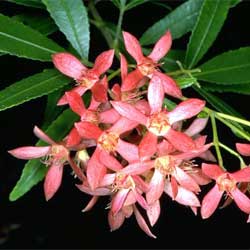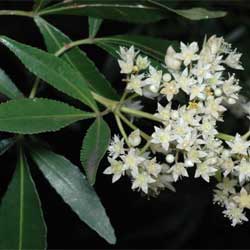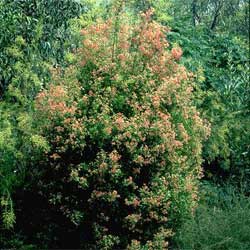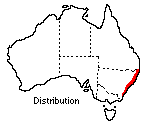Ceratopetalum gummiferum
 fruit |
 flowers |
 |
New South Wales Christmas Bush
Visitors to the Australian National Botanic Gardens are pleasantly surprised to find New South Wales Christmas Bush (Ceratopetalum gummiferum) thriving in Canberra and still red in late autumn. This effect varies according to the season but is a natural outcome of a cool summer and a mild autumn with no late heat waves, along with regular watering to give a good, and long, flowering season. In exceptional seasons the last fading tints are present until mid-June but generally they are over by late April or earlier.
 It
is hardy in Canberra as may be seen by older, 5m high specimens in these Gardens,
growing on sheltered rocky slopes, in full sun. The position was carefully chosen
when planting in existing sandy loam, and for several winters the plants were
covered nightly with sacking over a light timber frame. No protection is given
now and the only damage is withering of the margins of some leaves catching
early morning sun on frosty mornings.
It
is hardy in Canberra as may be seen by older, 5m high specimens in these Gardens,
growing on sheltered rocky slopes, in full sun. The position was carefully chosen
when planting in existing sandy loam, and for several winters the plants were
covered nightly with sacking over a light timber frame. No protection is given
now and the only damage is withering of the margins of some leaves catching
early morning sun on frosty mornings.
Many plants are growing freely on the slopes of the Sydney Region Flora sections and the Rainforest Gully, in roomy beds and sheltered by trees or other shrubs. The soil is built-up and mulched with bark chips or leaves, and light annual dressings of a complete fertiliser are given.
It is always interesting to watch the emergence of a plant's form from the beginning, especially where at least a dozen can be observed. Young shrubs, loosely rounded at first and flowering at 50 cm high, show strong central, upright branches by the time they are 1.3 m high, and a pyramidal trend.
Like Bougainvillea and Poinsettia the petals are not the brightest part of the plant; in these plants the calyx lobes enlarge after flowering and are highly coloured. However, in C. gummiferum the flowers also are attractive; soft cream clusters over the light green glossy foliage. The leaves are thin, each consisting of three leaflets with finely toothed margins, and golden green while young in summer. At this time a well-watered shrub is beautifully tinted with cream flowers and the first pink tints.
Flowers open from December onwards in Canberra and as each one dies its calyx enlarges and turns red and papery, looking like four or five petals. The colour is a warm carmine*, uncommon among native plants at this time. Each 'flower' contains a single seed, a nut, which falls when ripe. Seed or cuttings are used in propagation and the species is commonly available from nurseries. When sowing, the whole fruit with calyx lobes attached should be sown.
Canberra gardeners can confidently plant this species in almost any soil or situation desired except that open to strong winds, which would spoil the foliage. It reaches about 6 m high, though in its native habitats it can be 10 m. In public grounds with some watering facilities, and around city buildings, it would be admired as a token to Australians of one of their best-loved wildflowers.
Some plants were temporarily set back by die-back in a wet year when root-rot fungus was prevalent in the area and if it is desired to grow Ceratapetalum in heavy soils some additional drainage is advisable.
A number of horticultural selections (cultivars) have been made of Ceratopetalum gummiferum and these are usually available from specialist nurseries. They may vary from the 'natural' plant in leaf colour or in the size and colour of the 'flowers'.
A related species, Ceratopetalum apetalum, is a handsome, glossy shrub or tree, rare in the Canberra district. It is upright, 5 m high, with large dark leaves, and bears open sprays of very small creamish flowers. One of its common names is Coachwood, alluding to one of its timber uses.
Plants known in some Australian states as Christmas Bush are entirely different and have no connection with Ceratopetalum.
Text by ANBG staff (1973)
* Horticultural Colour Chart, Royal Horticultural Society, London 1966, Red 47C
Name meaning: Ceratopetalum gummiferumCeratopetalum - from two Greek words meaning horned-petal, (one species has petals resembling stag’s horns); gummiferum - gum-bearing, alluding to the gum richly exuded from the bark. |
![An Australian Government Initiative [logo]](/images/austgovt_brown_90px.gif)

